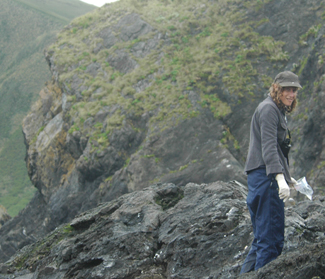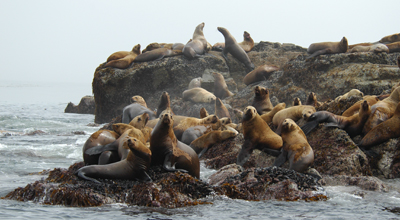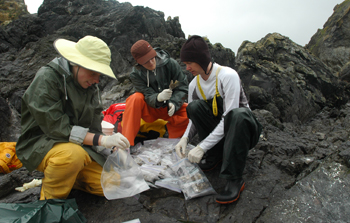
Scientists Seek to Reduce Disturbance on Rookeries
To better understand the diet of wild Steller sea lions populations, Consortium scientists visit haulouts and rookeries to collect fecal (scat) samples, which they then analyze for prey remains. However, scat collection often requires displacing the animals that are onshore, which can be disruptive in breeding areas (rookeries) at certain times of year.
To reduce disturbance on rookeries, scientists proposed using scats from adjoining bachelor male (non-breeding) haulouts as a proxy. If the scats of non-breeding males are similar enough in composition it may eliminate the need to disturb breeding females. This hypothesis was recently tested and published in the journal Aquatic Mammals by Dr. Andrew Trites (University of British Columbia) and Donald Calkins (formerly at the Alaska Department of Fish and Game, and now at the Alaska SeaLife Center).
Sampling Protocol
“We sought to develop a scat-sampling protocol that would minimize disturbance to Steller sea lions during the breeding season yet would yield accurate data about what sea lions eat,” the authors write. They compared scats from sexually mature Steller sea lions at one male haulout with those from three female-dominated rookeries at Forrester Island in southeast Alaska.
If the diet of bachelor bulls was similar enough to that of nearby breeding females, it could be useful as a proxy in future studies. That is, it could help to predict the diet of females without sampling the breeding population and with minimal intrusion on the nearby bachelor bulls. Further, if the scats indicated a similar diet among the females, samples collected from one rookery could help to predict the diets of all breeding females in the vicinity, further reducing disturbance.
 Shared Diet
Shared Diet
“We found that it is not necessary to sample scats from all of the breeding sites that make up the Forrester Island complex because females using these rookeries all have the same diet,” the authors reported. Female diets contained gadids, salmon and small oily forage fish, with fewer rockfish, flatfish, cephalopods, and other fishes.
 Compared to females, males consumed significantly fewer salmon and more pollock, flatfish, and rockfish. These dietary differences suggest that males and females may forage in separate areas, or that their relative physical size affects their ability to capture certain prey.
Compared to females, males consumed significantly fewer salmon and more pollock, flatfish, and rockfish. These dietary differences suggest that males and females may forage in separate areas, or that their relative physical size affects their ability to capture certain prey.
This study shows that female diets can be determined from samples collected at a single site within a rookery complex. Thus, a rotating schedule of scat collection from one breeding group could determine the diet of all local breeding females while reducing long-term disturbance in the population. Unfortunately, the male diet at Forrester Island differed sufficiently from that of breeding females to prevent its use as a proxy for female diet.
To ensure the long-term conservation of the species, scientists must balance the need to accurately determine what Steller sea lions eat with the cost of obtaining this information. Future comparisons of dietary information from other rookeries and haulouts in Alaska will help to determine how many rookeries and haulouts need to be sampled to accurately determine what Steller sea lions are eating.
June 2, 2008
SEE PUBLICATION:
|

|

 |
||||||||||||
